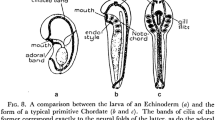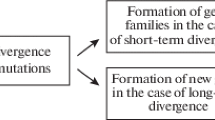Abstract
American biologists in the late nineteenthcentury pioneered the descriptive-comparativestudy of all cell divisions from zygote togastrulation – the cell lineage. Data fromcell lineages were crucial to evolutionary anddevelopmental questions of the day. One of themain questions was the ultimate causation ofdevelopmental patterns – historical ormechanical. E. B. Wilson's groundbreakinglineage work on the polychaete worm Nereis in 1892 set the stage for (1) an attackon Haeckel's phylogenetic-historical notion ofrecapitulation and (2) support for mechanisticexplanations of cleavage patterns. As morelineage work – especially Lillie's work on Unio and Conklin's on Crepidula – becameavailable in the mid-late 1890s, mechanism wastempered with more evolutionary, homology-basedviews. However, as I show by focusing on threemajor issues – homology, body plans and lifehistory – these views were primarily based onthe precocious segregation and prospectivesignificance – what the cell became not what itwas. Even on issues like adaptation, mostlineagists argued teleologically from the adultbackward. Most cell lineage workers, by 1900,were to varying degreesmechanist/experimentalist and recapitulationistsimultaneously. The exception was E. G.Conklin, whose views were more akin to aDarwinian evolutionist than either mechanist orrecapitulationist. Lineage work eventuallydeclined and by 1907 published accounts of newlineages had basically stopped. I argue thatestablished workers and younger researchersstopped wanting to take on cell lineageprojects because the general patterns were thesame for all the spiralians while the specificsshowed too much variation. It was hard totheoretically encompass or analyze the minutiaeof variation in a recapitulationist ormechanist framework. The only establishedworker who continued to do comparative lineagestudies was E. G. Conklin, perhaps because thevariation could best be accommodated byDarwinian evolution.
Similar content being viewed by others
References
Blochmann, F. 1881. “Über die Entwicklung der Neritina fluviatilus.” Zeitschrift für wissenschaftliche Zoologie 36: 125–174.
Boyer, B. C. and J. Q. Henry. 1998. “Evolutionary Modifications of the Spiralian Developmental Program.” American Zoologist 38(4): 621–633.
Casteel, D. B. 1904. “The Cell-Lineage and Early Development of Fiona marina, a Nudibranch Mollusk.” Proceedings of the Academy of Natural Sciences (Philadelphia) 56: 325–401.
Child, C. M. 1899. “The Significance of the Spiral Type of Cleavage and Its Relation to the Process of Differentiation.” In Biological Lectures Delivered at the Marine Biological Laboratory of Wood's Hole, pp. 231–266. Boston: Ginn & Co.
Conklin, E. G. 1897. “The Embryology of Crepidula, a Contribution to the Cell Lineage and Early Development of Some Marine Gastropods.” Journal of Morphology 13: 1–266.
Conklin, E. G. 1905. “Organization and Cell-lineage of the Ascidian Egg.” Proceedings of the Academy of Natural Sciences (Philadelphia) 13: 1–119.
Delsman, H. C. 1914. “Entwicklungsgeschichte von Littornia obtusata.” Tijdschrift der Nederlandsche Dierkundige Vereeniging 14: 383–498.
―1915. “Eifürchung und Gastrulation bei Emplectonema gracile.” Tijdschrift der Nederlandsche Dierkundige Vereeniging 14: 68–109.
―1916. “Eifurchung und Keimblätterbildung bei Scoloplos armiger.” Tijdschrift der Nederlandsche Dierkundige Vereeniging 14: 383–498.
Freeman, G. and J. W. Lundelius. 1992. “Evolutionary Implications of the Mode of D Quadrant Specification in Coelomates with Spiral Cleavage.” Journal of Evolutionary Biology 5(2): 205–247.
Gerould, J. H. 1906. “The development of Phascolosoma (Studies on the Embryology of the Sipunculidae II).” Zoologische Jahrbücher. Abteilung für Anatomie und Ontogenie der Tiere 23: 77–162.
Gilbert, S. F. 1978. “The Embryological Origins of the Gene Theory.” Journal of the History of Biology 11(2): 307–352.
Guralnick, R. P. and D. R. Lindberg. 2001. “Reconnecting Cell and Animal Lineages: What Do Cell Lineages Tell Us About Evolution and Development of Spiralia?” Evolution 55: 1501–1519.
Gustafson, R. G. and R. A. Lutz. 1992. “Larval and Early Post-Larval Development of the Protobranch Bivalve Solemya velum (Mollusca: Bivalvia).” Journal of the Marine Biological Association of the United Kingdom 72(2): 383–402.
Hammarsten, O. 1918. “Embryonalentwicklung der Malacobdella grossa.” Stockholm Zoologiska Institutionen Arb 1: 1–89.
Heath, H. 1899. “The Development of Ischnochiton.” Zoologische Jahrbücher. Abteilung für Anatomie und Ontogenie der Tiere 12: 567–656.
Ivanov, A. V. 1988. “Analysis of the Embryonic Development of Pogonophora in Connection with the Problems of Phylogenetics.” Zeitschrift für zoologische Systematik und Evolutionsforschung 26(3): 161–185.
Kumé, M. and K. Dan. 1957. Invertebrate Embryology. Bai Fu Kan Press.
Lankester, E. R. 1877. “Notes on the Embryology and Classification of the Animal Kingdom.” Quarterly Journal of the Microscopical Science 17: 399–454.
Lillie, F. R. 1895. “The Embryology of the Unionidae.” Journal of Morphology 10: 1–100.
―1898. “Adaptation in Cleavage.” In Biological Lectures Delivered at the MarineBiological Laboratory of Wood's Hole, pp. 43–56. Boston: Ginn & Co.
Maienschein, J. 1978. “Cell Lineage, Ancestral Remembrance, and the Biogenetic Law.” Journal of the History of Biology 11(1): 129–158.
Marcus, E. 1939. “Bryozoarios Marinhos Brasileiros III.” Faculdade de Filosofia, Ciencias e Letras Universidade de Sao Paulo Zoologia 3: 11–253.
Mead, A. D. 1897. “The Early Development of Marine Annelids.” Journal of Morphology 13: 227–326.
―1899. “The Origin of the Prototroch.” In Biological Lectures Delivered at the Marine Biological Laboratory of Wood's Hole, pp. 113–138. Boston: Ginn & Co.
Meisenheimer, J. 1900. “Entwicklungsgeschichte von Dreissena polymorpha.” Zeitschrift für wissenschaftliche Zoologie 69: 1–137.
Nelson, J. A. 1904. “The Early Development of Dinophilus: A Study in Cell Lineage.” Proceedings of the Academy of Natural Sciences (Philadelphia) 56: 687–737.
Newby, W. W. 1940. “The Embryology of the Echiuroid Worm Urechis caupo.” Memoirs of the American Philosophical Society 16: 1–213.
Nyhart, L. K. 1995. Biology Takes Form. The University of Chicago Press.
Robert, A. 1902. “Recherches sur le Développement des Troches.” Archives de zoologie experimentale et generale 30: 269–538.
Schmidt, G. A. 1925. “Untersuchungen über die Embryologie der Anneliden I. Die Embryonalentwicklung von Piscicola geometra Blainv.” Zoologische Jahrbücher. Abteilung für Anatomie und Ontogenie der Tiere 47: 319–428.
―1944. “Adaptive Significance of the Pecularities of the Cleavage Process in Leeches.” Zhurnal obshchei biologii 5: 284–303.
Smallwood, W. M. 1904. “The Maturation, Fertilization and Early Cleavage of Haminea solitaria (Say).” Bulletin of the Museum of Comparative Zoology 45(4): 1–60.
Surface, F. M. 1907. “The Early Development of a Polyclad Planocera inquilina.” Proceedings of the Academy of Natural Sciences (Philadelphia) 59: 514–559.
Tannreuther, G. 1915. “The Embryology of Bdellodrilus philadelphicus.” Journal of Morphology 26: 143–216.
Torrey, J. C. 1904. “Early Development of Thalessema mellita.” New York Academy of Sciences 14: 165–246.
Treadwell, A. L. 1900. “Equal and Unequal Cleavage.” In Biological Lectures Delivered at the Marine Biological Laboratory of Wood's Hole, pp. 93–112. Boston: Ginn & Co.
―1901. “The Cytogeny of Podarke obscura.” Journal of Morphology 17: 399–486.
Valentine, J. W., D. Jablonski and D. Erwin. 1999. “Fossils, Molecules and Embryos: New Perspectives on the Cambrian Explosion.” Development 126(5): 851–859.
Van den Biggelaar, J. A. M. and G. Haszprunar. 1996. “Cleavage Patterns and Mesentoblast Formation in the Gastropoda: An Evolutionary Perspective.” Evolution 50(4): 1520–1540.
Wilson, E. B. 1892. “The Cell Lineage of Nereis. A Contribution to the Cytogeny of the Annelid Body.” Journal of Morphology 6: 361–480.
―1894. “The Embryological Criterion of Homology.” In Biological Lectures Delivered at the Marine Biological Laboratory of Wood's Hole, pp. 101–124. Boston: Ginn & Co.
―1898. “Cell-Lineage and Ancestral Reminiscence.” In Biological Lectures Delivered at the Marine Biological Laboratory of Wood's Hole, pp. 21–42. Boston: Ginn & Co.
Author information
Authors and Affiliations
Rights and permissions
About this article
Cite this article
Guralnick, R. A Recapitulation of the Rise and Fall of the Cell Lineage Research Program: The Evolutionary-Developmental Relationship of Cleavage to Homology, Body Plans and Life History. Journal of the History of Biology 35, 537–567 (2002). https://doi.org/10.1023/A:1021119112943
Issue Date:
DOI: https://doi.org/10.1023/A:1021119112943




